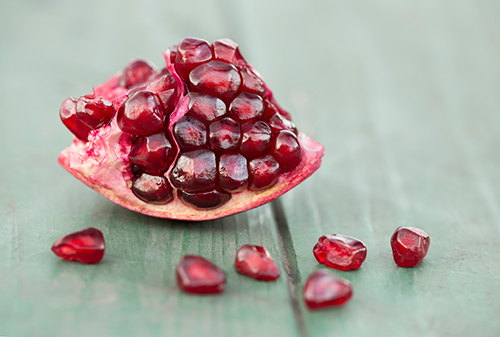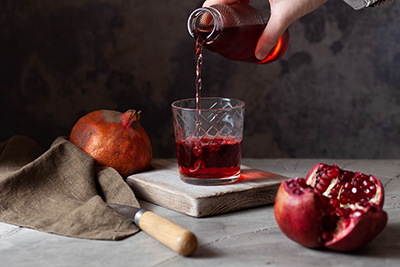Contents
Knowledge of POMEGRANATE health benefits goes back centuries. Its color has been of great interest, especially in Oriental societies. The Arabs were great enthusiasts and advocates of its cultivation, making it the symbol of the Muslim empire of Granada in the southern Iberian Peninsula.
The pomegranate’s crimson blossoms look like astounding flames in contrast to the dark green background of the tree’s leaves. The petite fruit beads, full of prized juice, are excellent as drops of blood or rubies. Solomon the Wise compared his beloved’s cheeks to the pomegranate 3000 years ago.

Pomegranate Nutritional Facts
The pomegranate contains several carbohydrates that surpass most other fruits: 15.6 percent (bananas reach 21 percent). Its protein content is close to one percent, which is respectable, bearing in mind that this is fresh fruit. Fats are less than 0.3 percent of their weight. The pomegranate contains vitamins C, E, and B6, containing significant amounts of B1, B2, and niacin. It does not contain beta-carotene (provitamin A). The most plentiful minerals are copper, iron, and potassium.
Amongst its non-nutritive elements, the following are worth mentioning:
TANNINS, in tiny amounts. These are much more prevalent in the fruit’s RIND or the MEMBRANES that divide the seed sacs. These tannins have an astringent and anti-inflammatory impact on the mucosa of the digestive tract.
CITRIC ACID and other organic acids give the pomegranate its pleasant bittersweet taste and a portion of the beneficial effect on the intestine (it contributes to restoring the intestinal bacterial flora).
ANTHOCYANINS: These reddish or bluish vegetable pigments in the flavonoid group behave as antiseptics, anti-inflammatory elements in the digestive tract, and potent antioxidants within the cells, halting the aging process and cancerous degeneration. It also has a diuretic effect.
PELLETIERINE: This alkaloid is an efficient vermifuge (eliminates intestinal parasites) found predominantly in the bark of the tree’s ROOTS. The membranes and rind also include this alkaloid, not seed sacs. Together, these components give the pomegranate properties: vermifuge, anti-inflammatory, astringent (if the internal membranes are consumed), remineralizer, alkalizer, and depurant.
Pomegranate Health Benefits
INTESTINAL DISORDERS: Pomegranate health benefits are appropriate in infectious diarrhea caused by colitis or gastroenteritis thanks to its astringent and anti-inflammatory effect on the digestive tract. It is also helpful in flatulence (excess gas) or intestinal cramps. Remarkable results have been attained in chronic cases such as granulomatous colitis (Crohn’s disease) or ulcerative colitis.

INTESTINAL PARASITES, tenia, or tapeworm. If an intense vermifuge effect is required, either a maceration of the BARK, which is very bitter, or of the inner walls of the pomegranate may be employed.
EXCESS STOMACH ACID: Its astringent action reduces gastric juice’s production and inflammation in an irritated stomach.
IRON DEFICIENCY ANEMIA: The pomegranate contains a significant amount of copper (70 ug/100 grams), a trace element that facilitates iron absorption.
ARTERIOSCLEROSIS: Because of its rich content of flavonoids and antioxidant vitamins (C and E), which halt the processes of arterial aging, the pomegranate is advised in cases of diminished arterial blood flow. It is precious in preventing heart attacks and cardiac health in general.
HIGH BLOOD PRESSURE: Because of their potassium richness and sodium’s virtual absence, pomegranates are appropriate for hypertension patients. They help avoid excessive systolic and diastolic pressure.
METABOLIC DISORDERS: Pomegranates are of value in cases of gout, excess uric acid, and obesity because of their alkalizing and depurant effect.
Pomegranate Scientific Facts
- Scientific name: Punica granatum L.
- Other names: Chinese apple, dalima, grenade.
- French: Grenade.
- Spanish: Granada.
- German: Granatapfel.
- Description: The fruit of the pomegranate tree, an evergreen belonging to the botanical family Punicaceae, reaches four meters in height. The fruit contains many sacs filled with pink or reddish pulp juice. Each sac contains a seed.
- Environment: The pomegranate is originally from the Near East, where it spread throughout the Mediterranean. It is grown in Iran, Turkey, Mediterranean countries, and hot regions on the American continent, such as Brazil and California.

How to use and Prepare Pomegranate Medicinally
- NATURAL: The pomegranate is amongst the most effortlessly stored fruits after harvest. It ripens well off the tree with minimal effort on its nutritional properties. Pomegranates stored in a dry, cool place can last up to 6 months. If its anti-parasitic effect is unsought, remove the internal membranes that separate the sacs because of their bitter taste.
- JUICE: Pomegranate juice is very flavorful and refreshing. It is easily obtained using a household juicer.
- GRENADINE: This syrup is made by cooking pomegranate juice with sugar. It can be stored for months. It is used as a beverage, watered down, or to flavor fruit salads.
Extra Preparation Tips
- Split the fruit in half
- Tap the rind with the underside of a spoon to free the sacs
- Remove the membrane portions that may have come out with the sacs. If necessary, add honey and enjoy it with a spoon.
DISCLAIMER: All content on this website is presented solely for educational and informational objectives. Do not rely on the information provided as a replacement for advice, diagnosis, or treatment from a qualified medical expert. If you are pregnant, nursing, or have any preexisting medical concerns, talk to your doctor before using any herbal or natural medicines.
REFERENCES
- George D. Pamplona-Roger, M.D. “Encyclopedia of Foods and Their Healing Power.” George D. Pamplona-Roger, M.D. Encyclopedia of Foods and Their Healing Power. Trans. Annette Melgosa. Vol. 2. Chai Wan: Editorial Safeliz, 2005. 236, 237. Print. [Pomegranate health benefits]
- https://www.mayoclinic.org/healthy-lifestyle/nutrition-and-healthy-eating/in-depth/fiber/art-20043983
- https://pubmed.ncbi.nlm.nih.gov/31298147/
- https://pubmed.ncbi.nlm.nih.gov/24926616/
- https://www.ncbi.nlm.nih.gov/pmc/articles/PMC7266558/
